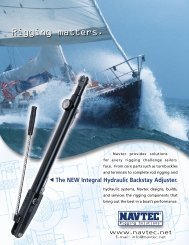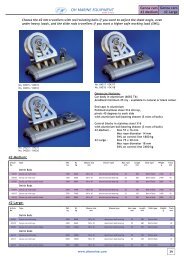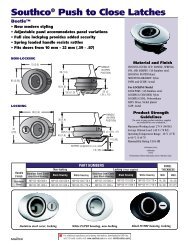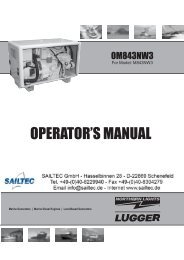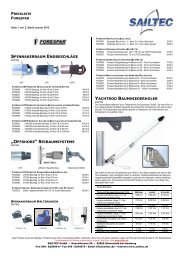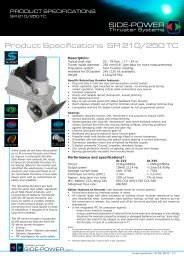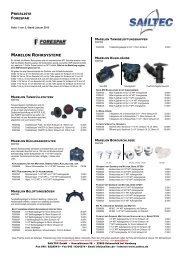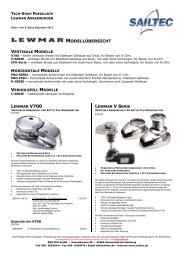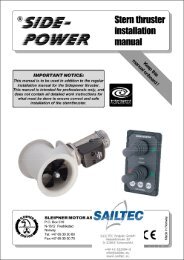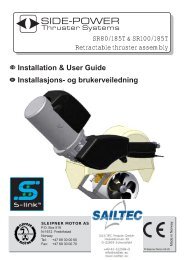Navtec Rod Rigging Service Navtec Rod Rigging ... - SAILTEC GmbH
Navtec Rod Rigging Service Navtec Rod Rigging ... - SAILTEC GmbH
Navtec Rod Rigging Service Navtec Rod Rigging ... - SAILTEC GmbH
Create successful ePaper yourself
Turn your PDF publications into a flip-book with our unique Google optimized e-Paper software.
<strong>Navtec</strong> <strong>Rod</strong> <strong>Rigging</strong> <strong>Service</strong><br />
The question of how long does a <strong>Navtec</strong> rod rigging system lasts is not an easy one to answer because there<br />
are many variables that can come into play. The major factors to consider are:<br />
1. What loads are put on each of the pieces of rod in comparison to each piece of rod's breaking strength;<br />
2. The sailing conditions in which that the boat has predominantly sailed;<br />
3. The amount of care and maintenance that has been given to the rigging;<br />
4. The amount of time and/or miles the boat has been in service;<br />
5. The severity of the marine environment the particular boat has experienced (fresh vs. salt and temperate vs.<br />
tropical).<br />
The sizes of the shrouds and stays used on each boat are picked by either the yacht designer, the mast<br />
builder or possibly by the rigger who installed and headed it. A racing boat tends to use relatively smaller rod<br />
sizes to keep the weight and windage down, which will shorten the rod's life since the maximum normal sailing<br />
loads may approach 50% of the breaking strength of the rod. A cruising boat tends to have a higher safety<br />
factor when the rod sizes are chosen so that the loads would only be 15-25% of the breaking strength at<br />
maximum normal sailing conditions. Another factor that makes any prediction of rigging life harder is the fact<br />
that rigging costs invariably come into play when sizing choices are made. Smaller rod sizes for a given application<br />
yield shorter rod life, as the safety factors involved are reduced.<br />
If the boat has been predominantly sailed in heavy air conditions, the life of the rod will be shorter than if the<br />
boat was sailed in lighter wind conditions or sailed very infrequently. The higher the rigging is stressed on a<br />
regular basis, the shorter its life span will be. An analogy: a car's engine won't last as long if it is continually<br />
revved up to the red line.<br />
If the rigging has been periodically checked, the end fittings have been rinsed with fresh water, and general<br />
care and maintenance have been employed, it will last longer. For example, a turnbuckle can build up corrosion<br />
so that it won't turn, or a spreader bend if left covered in leather or tape can eventually corrode the spreader<br />
or the spreader bend. Basic maintenance can go a long way in extending the rigging's life.<br />
The miles the boat has sailed and type of marine climate are also factors in predicting the remaining life of the<br />
rigging. It has been observed that corrosion rates are significantly higher in tropical climates; and with use, any<br />
rigging will eventually deteriorate and wear out.<br />
With all the factors listed above, it is clear that there are many variables that must be considered to determine<br />
the life of the rod. As a general rule, <strong>Navtec</strong> uses a figure of 40,000 sailing miles as a time when a thorough<br />
inspection should be done. This would include inspection of all the rod heads and end fittings. If any of the<br />
heads are cracked or worn, the rod should at least be reheaded. That doesn't mean that the rod itself would<br />
need to be replaced; that would depend on whether the turnbuckles had enough stroke to compensate for a<br />
shorter piece of rod. In a good installation, the rod will typically last significantly longer than the heads on the<br />
end of the rod.<br />
After a thorough inspection with no problems found, depending on the installation, it may be reasonable to<br />
expect the rod to last another 40,000 miles. However, prudence would dictate what should be done. If the boat<br />
is going to be used for just local day sailing, you could make frequent inspections and perform repairs as soon<br />
as they were needed. But if the boat is going to do a long ocean passage or an extended cruise, it would be<br />
smarter to rehead or replace the rod prior to departure.<br />
One item that Navt ec does recommend replacing after 10 years of use or 40,000 miles (whichever comes first)<br />
is the turnbuckle screws. With the stress concentrations due to the threads, cracks could be forming that may<br />
not be noticed until they fail. The screws may last for many additional years, but it is much cheaper to replace<br />
a few rigging screws than to replace a mast and all of the rigging.<br />
<strong>SAILTEC</strong> <strong>GmbH</strong> • Hasselbinnen 28 • 22869 Schenefeld bei Hamburg<br />
Fon 040 / 822994-0 • Fax 040 / 8304279 • Email info@sailtec.de • Internet www.sailtec.de
Seite / Page 2<br />
What should I look for when inspecting my rigging?<br />
Cracks in rigging components, especially cracks that are orientated transverse to the load are a sign of impending<br />
failure. Cracks can be found using visual inspection, a magnifier, or by dye penetrate testing. X-ray<br />
testing, eddy current testing, ultrasonic testing and other professional methods can be used.<br />
For visual inspection, the rod or fittings must be cleaned or polished to expose the cracks. Rusty areas frequently<br />
indicate cracks underneath. In addition to cracks, you should look for corrosion, pitting and rust. Any<br />
areas showing discoloration or potential corrosion should be thoroughly cleaned and inspected. If any evidence<br />
of corrosion remains after this cleaning, please consult an authorized <strong>Navtec</strong> rigger. Pitting and/or corrosion<br />
could require reheading or replacement of the rod or replacement of the fitting.<br />
Alignment of the rod and fittings to the load is very important to give good life of rod (or wire or other) rigging.<br />
Misalignment of fittings, caused by interference or bends in the rod, should be checked. Kinks or bends in the<br />
rod result in increased local stress and dramatically reduce the life of the rod. If a fitting or rod has operated in<br />
a bent, kinked or misaligned condition, it should be replaced, as the damage due to cycling cannot be undone.<br />
If a rod is bent and then straightened before it is used again, depending on the severity of the bend, it will frequently<br />
provide normal life. This is a judgment call and the <strong>Navtec</strong> Engineering Department should be consulted.<br />
Depending on the size and use of the yacht it is frequently wise to have the rig inspected by a professional<br />
annually.<br />
Contact <strong>Navtec</strong> or Sailtec for further information.




